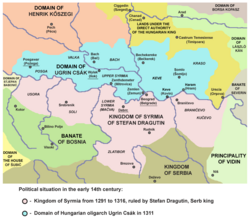Realm of Stefan Dragutin
This article includes a list of general references, but it lacks sufficient corresponding inline citations. (February 2013) |
Realm of Stefan Dragutin Област Стефана Драгутина Oblast Stefana Dragutina | |||||||||||||||||||||
|---|---|---|---|---|---|---|---|---|---|---|---|---|---|---|---|---|---|---|---|---|---|
| 1282–1325 | |||||||||||||||||||||
 Kingdom of Syrmia of Stefan Dragutin (1291-1316) | |||||||||||||||||||||
| Status | initially vassal kingdom of the Kingdom of Hungary,[1] later an independent kingdom | ||||||||||||||||||||
| Capital | Debrc and Belgrade | ||||||||||||||||||||
| Government | Hereditary monarchy | ||||||||||||||||||||
| Historical era | Middle Ages | ||||||||||||||||||||
• Established | 1282 | ||||||||||||||||||||
• Disestablished | 1325 | ||||||||||||||||||||
| |||||||||||||||||||||
| Today part of | Serbia, Bosnia and Herzegovina, Croatia | ||||||||||||||||||||
The Realm of Stefan Dragutin.
Territory

In the Middle Ages, "
History
Around 1291 and with the help of Milutin, Dragutin expanded his territory by annexing the regions of
Towards the end of his life, Stefan Dragutin broke away from his Hungarian allies and strengthened his ties with Serbia. He later took monastic vows, died in 1316 and was buried in the monastery of Đurđevi stupovi, near present-day Novi Pazar.
After the death of Dragutin, his son
After being defeated again by supporters of Milutin's son and successor, Stefan Dečanski, Vladislav retreated to the Kingdom of Hungary in 1324. Later, Stephen II reincorporated Soli and Usora into Bosnia. Belgrade and the northern part of the banate of Mačva along the river Sava remained under the rule of the Kingdom of Hungary, while Braničevo and the southern part of Mačva remained Serbian. The kingdoms of Serbia and Hungary would contest Mačva for the next century.
Rulers
| Monarch | Reign |
|---|---|
 Stefan Dragutin |
1282–1316 |
Vladislav
|
1316–1325 |
Annotations
- Scarcer historiographical names include "Dragutin's State" (Serbian: Драгутинова држава / Dragutinova država).
References
- ^ a b c Fine 1994, p. 220.
- ^ Vásáry 2005, p. 104.
- ^ Ћирковић & Михаљчић 1999, p. 167.
- ^ Mrgić & Živković 2008, p. 368.
- ISBN 9788670251830.
а Драгутин у „престо своје владавине, у државу сремске земље"
- ^ Dinić 1978, p. 124.
- ^ Орбин 1968, p. 24.
Sources
- ISBN 9782825119587.
- ISBN 9781405142915.
- ISBN 9788683233014.
- Dinić, Mihailo (1978). Српске земље у средњем веку: историјско-географске студије. Српска књижевна задруга.
- Engel, Pál (2001). The Realm of St. Stephen: A History of Medieval Hungary, 895-1526. London & New York: I.B.Tauris. ISBN 9781850439776.
- ISBN 0-472-08260-4.
- Jireček, Constantin (1911). Geschichte der Serben. Vol. 1. Gotha: Perthes.
- Krstić, Aleksandar R. (2016). "The Rival and the Vassal of Charles Robert of Anjou: King Vladislav II Nemanjić". Banatica. 26 (2): 33–51.
- Mrgić, Jelena; Živković, Tibor (2008). Северна Босна: 13-16. век. Историјски институт. ISBN 9788677430719.
- Orbini, Mauro (1601). Il Regno de gli Slavi hoggi corrottamente detti Schiavoni. Pesaro: Apresso Girolamo Concordia.
- Орбин, Мавро (1968). Краљевство Словена. Београд: Српска књижевна задруга.
- Vásáry, István (2005). Cumans and Tatars: Oriental Military in the Pre-Ottoman Balkans, 1185–1365. Cambridge: Cambridge University Press. ISBN 9781139444088.
External links
- Map of Dragutin's and Milutin's state, at the Serbian Governmentarchive web site
- Map of the realm of Stephan Dragutin, on a map of the crown of Aragon and the house of Anjou in the Middle Ages (up to ca. 1380)"
- Map of the realm of Dragutin Istvan, on a map of "Hungarian oligarchs" 1301-1310
- Map of "Tulso Szeremseg", on a map of the Kingdom of Hungary in the 13th century
- Map of the "Statelet of Stefan Dragutin" at the Wayback Machine (archive index) (from book "Hrvatska povijest u 25 karata", written by Stjepan Srkulj and Josip Lučić)
